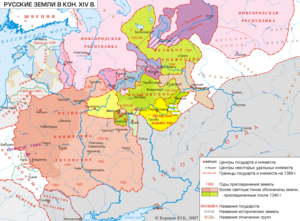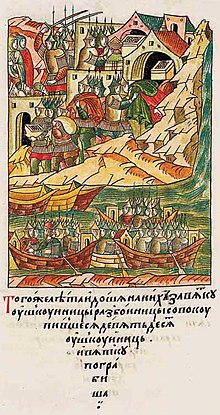Vyatka Land

Vyatka Land (Russian: Вятская земля) is a historical region in the basin of the Vyatka River, approximately corresponding to modern-day Kirov Oblast in Russia.
While the Permians were its original inhabitants, it was gradually settled by Slavic settlers whose arrival is traditionally dated to the late 12th century. Vyatka Land, being geographically isolated from the rest of the Russian lands, sometimes accepted the suzerainty of other Russian and Tatar states but de facto enjoyed a large degree of independence until it was annexed by the Grand Principality of Moscow in 1489.
History
[edit]
Udmurts inhabited Vyatka Land before the arrival of Slavic settlers. According to the Legend of the Vyatka Land, they came from Novgorod in 1174, conquered Kotelnich and Nikulitsyn with the supernatural help of saints Boris and Gleb and founded Khlynov (now Kirov), which became the main settlement of Vyatka Land (often called Vyatka as well).[1] This account was disputed by some historians who consider the Legend to be a much later and unreliable source.[2] The settlement appears in the archeological record of the 11th–13th centuries and intensifies after the Mongol conquest of Rus'.[3] The first undisputed mention of Vyatka in Russian chronicles dates to 1374 when a band of ushkuyniks from Vyatka raided Sarai. According to an Udmurt legend, the Udmurts who lived in the settlement on the site of future Vyatka burned down their sanctuary and migrated east to the Cheptsa river.[4]
The Tatar prince Bektut conquered Vyatka Land in the 1390s. Some of the inhabitants were killed and others were captured. Ten years later, the prince Simeon Dmitrievich of Suzdal ruled in Vyatka, possibly as a vassal of the Golden Horde.[5] There was a rivalry between Vyatka and Ustyug which led to several battles fought in the late 14th and early 15th centuries.[6]
Some time in the first half of the 15th century, Vasily I, the grand prince of Moscow, took Vyatka Land from the Suzdalian line of princes and handed it to his brother Yury together with Galich. Yury lived in the latter and sent a deputy to Vyatka.[7] He fortified Khlynov (Vyatka), Kotelnich and Orlov and thereafter they were considered towns (goroda). Vyatka supported Yury and his son Dmitry Shemyaka against Vasily II in the Muscovite Civil War. Jonah, the metropolitan of Kiev and all Rus', accused the people of Vyatka (vyatchane) of cruelty, destroying churches and selling captives into slavery in 1452.[8] By that time the war had ended in victory for Vasily II and he subsequently organised several campaigns to subdue Vyatka. The first two were unsuccessful – the Muscovite generals were reportedly bribed off – and only the third one launched in 1459 succeeded. The Muscovite army took Kotelnich and Orlov and besieged Vyatka until it surrendered. It accepted the suzerainty of Moscow and was forced to pay tribute.[9]
Vyatka remained semi-independent even after formally accepting the suzerainty of the grand prince of Moscow. They fought together with other Muscovite forces against the Kazan Khanate in 1468; however, then khan Ibrahim of Kazan sent his troops to Vyatka and extracted a promise not to help Moscow against Kazan. When Ivan III gathered forces to attack Kazan in the following year, Vyatka refused to join the army, citing the promise to Ibrahim. In 1485, only a show of force made Vyatka join another Muscovite campaign against Kazan. The vyatchane raided both Tatar and Russian lands: in 1471, they looted Sarai, and in the 1480s, they twice attacked Muscovite lands on the Northern Dvina.[10]
Ivan III subjugated the lands of Perm in 1472, annexed Novgorod in 1478, and installed a pro-Russian khan after capturing Kazan in 1487.[11] Ivan then sent an army to subdue Vyatka in 1489,[11] under the command of Daniil Shchenya. Kotelnich and Orlov were taken without resistance. Khlynov was besieged on August 16. Khlynov notables presented gifts to the Muscovite generals and offered obedience to the grand prince. The generals demanded they hand over three atamans. This was debated for two days in the city and ultimately the vyatchane refused the demand. The Muscovite army started siege preparations, which caused Khlynov to surrender. The three atamans were beheaded in Moscow, the Vyatka nobles were resettled on the southern border of Muscovy and the merchants were resettled in Dmitrov.[10]
The scarcity of information on Vyatka led Nikolay Kostomarov to remark that "there is nothing in Russian history more obscure than the fortunes of Viatka and its region".[12][13]
Government
[edit]Vyatka Land was self-governed to a large degree; however, the nature of its government is not known for sure. The local leaders, known as voivodes (Russian: земские воеводы, romanized: zemskiye voyevody), were apparently elected and sometimes they are identified with atamans who headed military campaigns and raids.[14] There are no explicit mentions of a veche in Vyatka in surviving sources, and historians' opinions on its existence differ. Nikolay Kostomarov and some post-Soviet historians believed that it was the highest authority in Vyatka while Soviet historians argued that there is no proof of its existence.[12][2]
References
[edit]- ^ Костомаров 1868, pp. 241–244.
- ^ Jump up to: a b Тихонов 2007.
- ^ БердинскихТатаренкова 1995, p. 15.
- ^ Луппов 1958, p. 51.
- ^ Луппов 1958, pp. 52–55.
- ^ Луппов 1958, pp. 56–58.
- ^ Луппов 1958, p. 56.
- ^ Луппов 1958, p. 62.
- ^ Луппов 1958, pp. 62–63.
- ^ Jump up to: a b Луппов 1958, pp. 63–70.
- ^ Jump up to: a b Chew, Allen F. (1 January 1970). An Atlas of Russian History: Eleven Centuries of Changing Borders. Yale University Press. p. 32. ISBN 978-0-300-01445-7.
- ^ Jump up to: a b Feldbrugge 2017, pp. 525.
- ^ Костомаров 1868, p. 241.
- ^ Луппов 1958, pp. 71–72.
Sources
[edit]- Feldbrugge, Ferdinand J.M. (2017). A History of Russian Law: From Ancient Times to the Council Code (Ulozhenie) of Tsar Aleksei Mikhailovich of 1649. BRILL. ISBN 9789004352148. The year of losing independence (1452) appears to be incorrect as other sources (Kostomarov, Luppov) indicate that Vyatka accepted the suzerainty of Moscow in 1459 and was annexed in 1489.
- Костомаров, Николай Иванович (1868). Исторія Новгорода, Пскова и Вятки во время удѣльно-вѣчеваго уклада (in Russian). С.-Петербургъ: Типографія В. С. Эттингера.
- Луппов, П. Н. (1958). История города Вятки (in Russian). Кировское книжное издательство.
- Тихонов, А.Н. (2007). "К вопросу о вече в Вятской земле XIV-XV веков". Материальная и духовная культура народов Урала и Поволжья: история и современность: Мат-лы Междунар. науч.-практ. конференции, посв. 450-летию вхождения удмуртского народа в состав Российского государства (in Russian). Глазовский гос. педагогический институт. pp. 53–56. ISBN 978-5-93008-105-3.
- Бердинских, В. А.; Татаренкова, Л. С., eds. (1995). Энциклопедия земли Вятской. Т. 4 : История (in Russian). Городская газета. ISBN 5-86645-010-0.
Further reading
[edit]- Тихонов, А. Н. (2008). "Спор о народоправстве: вопрос о политическом строе Вятской земли XIV – XV вв. в советской и новейшей историографии". Россия в XX веке, общество и власть: проблемы региональной истории, историографии и источниковедения: Мат-лы межвуз. науч.-практ. конф. 12 дек. 2007 г (in Russian). Полиграфцентр ННГАСУ. pp. 22–28. ISBN 978-5-87941-521-6.
- Kropotkin, Peter Alexeivitch; Bealby, John Thomas (1911). . Encyclopædia Britannica. Vol. 28 (11th ed.). p. 222.